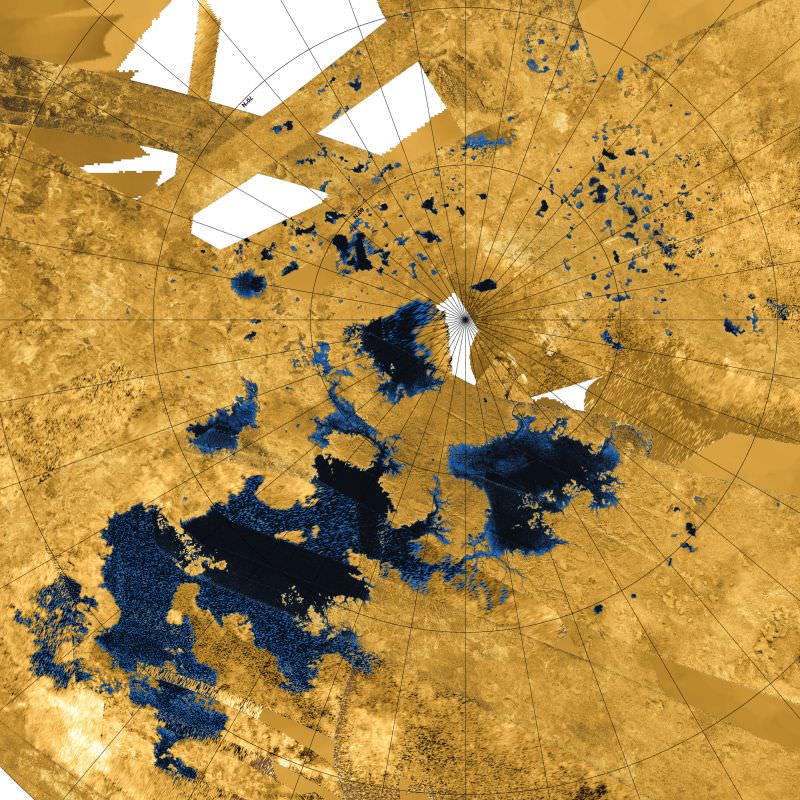Some lakes on Titan have ring-like shapes around them, and scientists are trying to find out how they formed. Understanding how they formed may tell us something about how the entire region they’re in, including the lakes, formed. The ring-shaped features are found around pools and lakes at Titan’s polar regions.
Thanks to the Cassini spacecraft, which spent 13 years studying Saturn and its moons, we know that the frigid moon Titan is an intriguing place. Cassini showed us that Titan has about 650 lakes and seas in its polar regions. We also know that about 300 of them have liquid ethane and methane in them, though they’re not all full.
“The formation of Titan’s lakes, and their surrounding features, remains an open question.”
Anezina Solomonidou, ESA research fellow at the European Space Astronomy Centre, and Lead Author of the study.
The bulk of the smaller lakes on Titan have sharp edges and flat floors. They can reach depths of 600 meters and they have narrow outer rims about 1 km wide.
But some of these lakes and pools have curious ring-shaped features around them that can extend up to 10 km inland. Scientists call them ramparts, and they totally enclose their host lake.
A new study took a deeper look at these rampart features. The study is titled “Spectral and emissivity analysis of the raised ramparts around Titan’s northern lakes.” The lead author is Anezina Solomonidou, an ESA research fellow at the European Space Astronomy Centre (ESAC.) They relied on data from Cassini’s Visual and Infrared Mapping Spectrometer (VIMS) to measure the emissivity of the ramparts and other features on Titan, to find any similarities and differences.
“The formation of Titan’s lakes, and their surrounding features, remains an open question,” Solomonidou said in a press release. “Ramparts may hold important clues about how the lake-filled polar regions of Titan became what we see today. Previous research revealed their existence, but how did they form?”
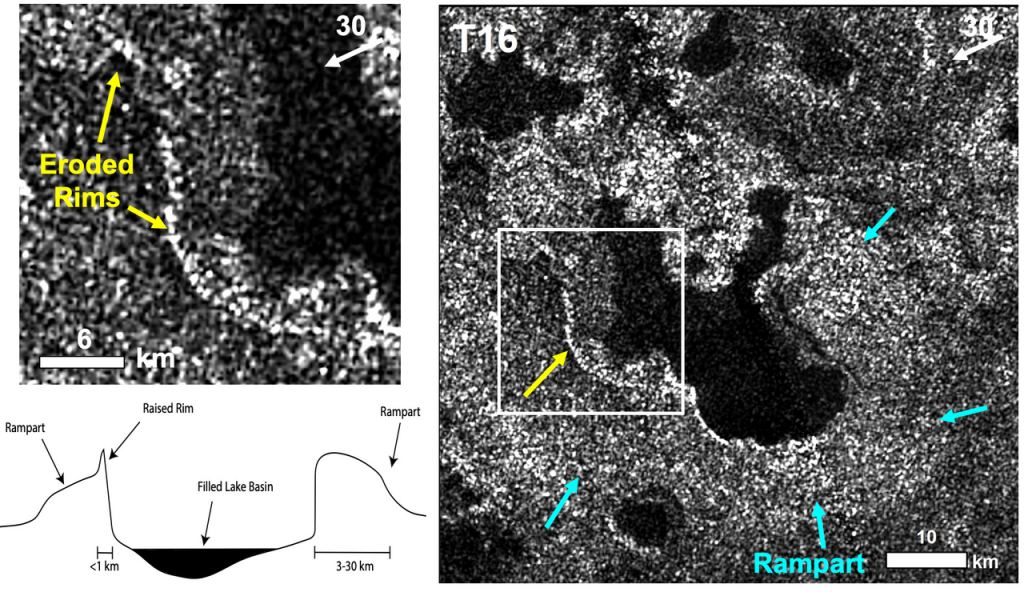
Right: Cassini RADAR image of one of Titan’s lake, Viedma Lacus, obtained using the instrument’s Synthetic Aperture Radar (SAR) Imager. Yellow arrows indicate portions of the raised rim near the lake, while cyan arrows indicate portions of the perimeter of the rampart feature that encloses nearly the entire lake.
Top left: A zoomed-in view of the raised rim.
Bottom left: Illustration of a lake with rampart and rim features. Rims involve higher slopes and are confined to within a few km of the lake, while ramparts enclose the entire lake and form broader mounds, up to tens of km. Image Credit: NASA/JPL-Caltech/ASI; ESA/A. Solomonidou et al. (2019)
The team of scientists examined five regions near Titan’s north pole, a region rich with lakes and raised ramparts. They also looked at three empty lakes in a nearby region for comparison. The team combined the VIMS data with data from Cassini’s Synthetic Aperture Radar (SAR) Imager.
The lakes ranged in size from smaller 30 km2 lakes to much larger ones, up to 670 km2 in size. All of the lakes were completely surrounded by ramparts that are up 200 m to 300 m high, and that extend up to 30 km inland from the lake edges.
What the study found is best expressed by the study’ lead author: “The spectral data showed that ramparts have a different composition with respect to their surroundings,” said Solomonidou. “The floors of empty lakes we studied also seem to be spectrally similar to the ramparts, suggesting that both empty basins and ramparts may be made from, or coated with, similar material, and may thus have formed in a similar way.”
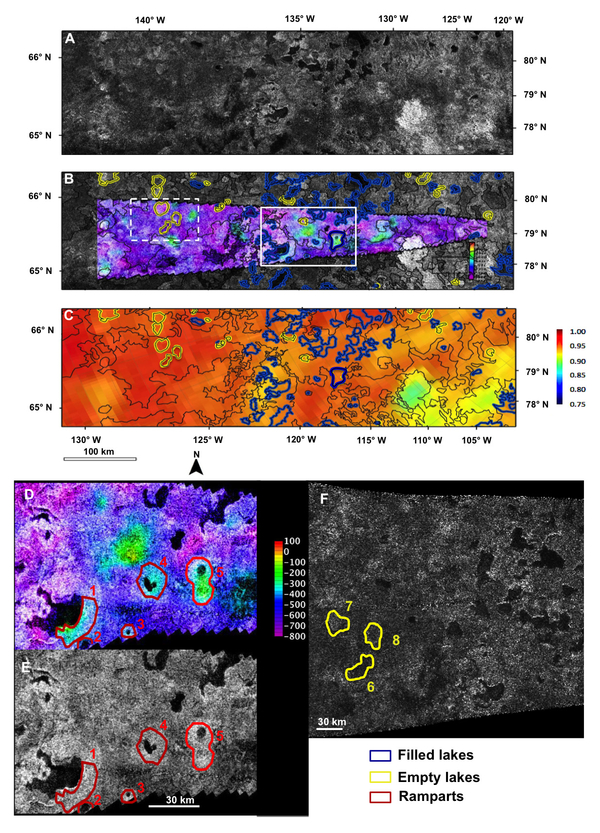
The spectral emissivity of the lakes and the ramparts bears resemblance to another of Titan’s features. The so-called labyrinth terrain is widespread on Titan, though it only covers about 5% of the moon’s surface. This labyrinth terrain was caused by liquid hydrocarbons flowing across Titan’s surface and carving out channels. Scientists suspect that the labyrinth terrain is rich in organic chemicals, and because of the spectral similarity between it and the ramparts and empty lake beds, it’s likely that the lake beds and ramparts are rich in organics, too.
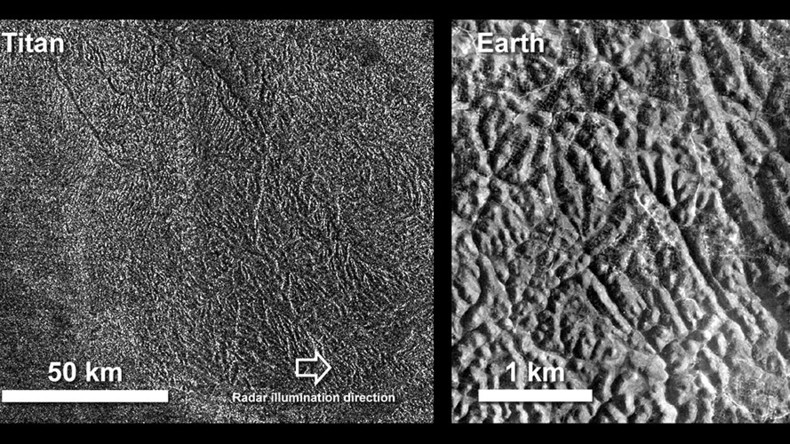
There’s something else curious about the ramparts surround some of Titan’s lakes. They always completely surround the host lake.
“Ramparts are also consistently complete: while rims and other features have been worn away and broken up over time, ramparts always completely encircle their lake,” said co-author Alice Le Gall, who analyzed the spectral emissivity of the ramparts. “This helps us to constrain the scenarios of how they might have formed.”
The authors suggest two possible mechanisms that could have formed these ramparts. They’re careful, though, to emphasize that this is preliminary work, and far from conclusive.
“It’s difficult to narrow down the exact mechanism for how these ramparts form, but with more research comes an increasing understanding of intriguing bodies such as Titan.”
ANEZINA SOLOMONIDOU, ESA RESEARCH FELLOW AT THE EUROPEAN SPACE ASTRONOMY CENTRE, AND LEAD AUTHOR OF THE STUDY.
The first possibility is built on the fact that empty lake floors and filled lakes have different elevations. Based on that, the authors think that a process involving a subsurface that is saturated with groundwater is responsible for the ramparts.
The second possibility is that the basin of a lake and the crust surrounding it first harden and then deflate, leading the lake to percolate down into the subsurface. The part of the region that doesn’t deflate is left protruding above the surrounding terrain to form a rampart.
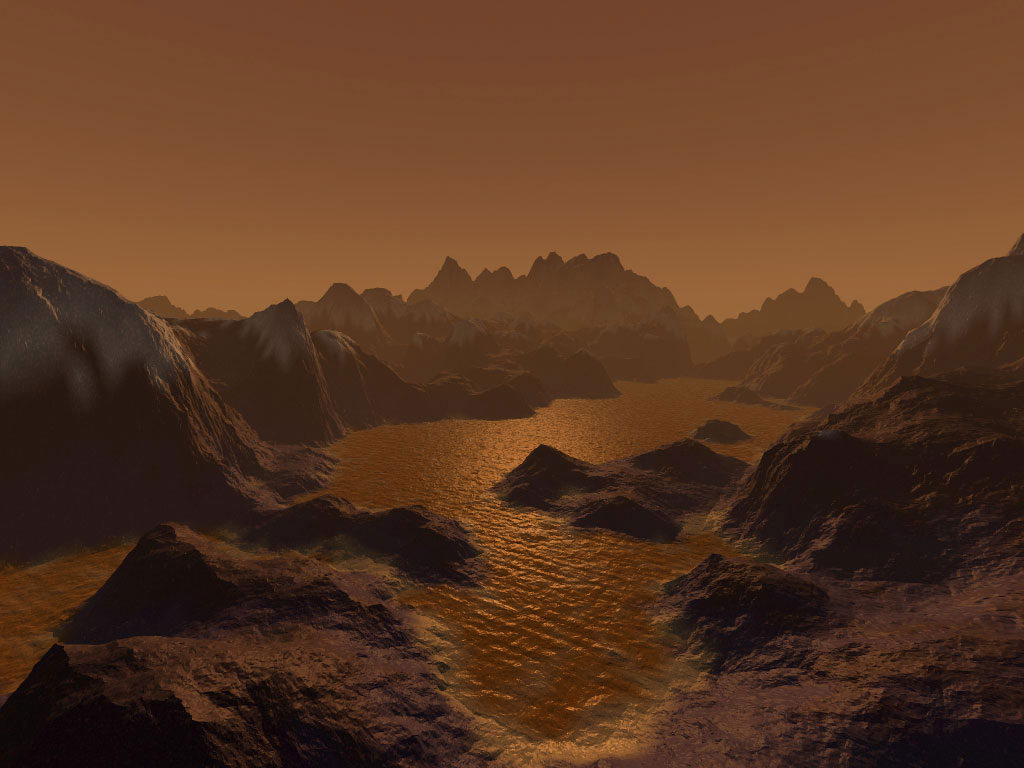
The fact that the ramparts are always complete, rather than broken down like the rims, suggests that the ramparts are older, as long as the rims are made of weaker material. In that scenario, a hydrocarbon lake would form first, then a rampart, and then a rim, which is eroded due to its weaker composition.
But if both the rim and the rampart are made of the same material, then that explanation doesn’t fit.
If both features are made of the same material, then the history of the lakes might go like this: First, a basin forms. Residual material from that would first form the rims, then the larger ramparts. If this is true, then lakes with ramparts would be younger than lakes without ramparts. The younger lakes simply haven’t been around long enough for their rampart to erode and be removed.
“It’s difficult to narrow down the exact mechanism for how these ramparts form, but with more research comes an increasing understanding of intriguing bodies such as Titan,” added Solomonidou.
The authors, like everyone else interested in oddball moons in our Solar System, are looking forward to the JUpiter ICy moons Explorer (JUICE) mission. JUICE is an ESA mission planned for launch in 2022 and arrival at Jupiter in 2029. It’ll spend three years exploring Jupiter and three of its moons: Callisto, Europa, and Ganymede, all of which are ocean-bearing worlds.

“The analysis of Cassini data of Saturn’s icy moons, in particular when combining data from multiple instruments, is highly relevant to prepare the JUICE mission that will explore Jupiter’s icy moons,” said co-author Olivier Witasse, who is also project scientist for ESA’s JUICE mission.
“Even if Titan is exceptional, with lakes and rains that are not found in Jupiter’s moons, knowing more about Titan adds a lot to our understanding of the Solar System’s icy moons collectively.”

